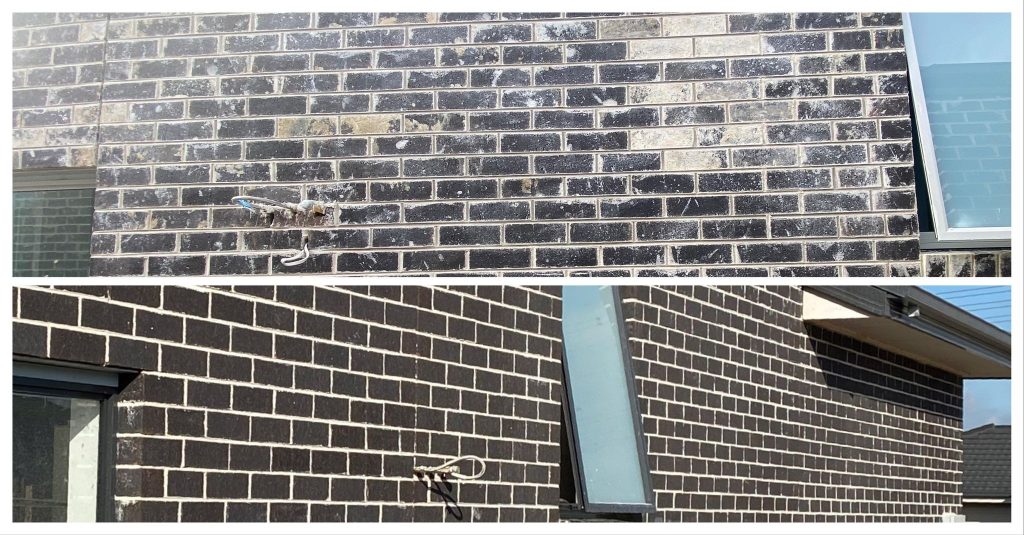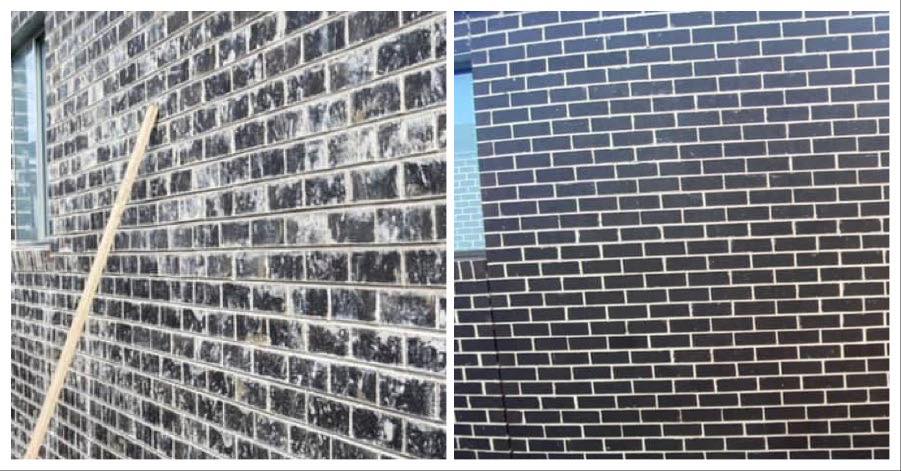
Brick Wash Melbourne Brick Cleaning Services
Enhance Your Property with Expert Brick Wash Acid Pressure Cleaning
Brick acid cleaning using hydrochloric acid is a powerful technique reserved for specific cleaning needs, particularly the removal of mortar stains. While hydrochloric acid can effectively tackle stubborn mortar stains, its use requires careful consideration and precision to avoid damaging the bricks. At Spotless Brick and Pressure Cleaning, we specialize in brick acid pressure cleaning in Melbourne, employing advanced techniques to rejuvenate your brickwork while ensuring the integrity of your bricks remains intact.
Understanding the Role of Hydrochloric Acid
Hydrochloric acid is commonly used in Brick Acid Pressure Cleaning to remove mortar stains from bricks. However, its potency means it should be used sparingly and exclusively for this purpose. When applied correctly, hydrochloric acid can effectively dissolve mortar stains, revealing clean and refreshed brick surfaces. Nevertheless, it’s essential to exercise caution to prevent overexposure and potential damage to the bricks.
Our Approach to Brick Acid Pressure Cleaning
At Spotless Brick Acid Pressure Cleaning, we prioritize the careful application of hydrochloric acid to achieve optimal results without compromising the structural integrity of the bricks. Our experienced technicians assess the condition of the bricks and determine the appropriate concentration and duration of acid exposure needed to remove mortar stains effectively. We utilize advanced pressure cleaning equipment to deliver precise and controlled application, ensuring thorough yet gentle cleaning.
Benefits of Our Brick Acid Pressure Cleaning Services
- Effective Stain Removal: Our brick acid pressure cleaning services effectively remove mortar stains, restoring the appearance of your brickwork.
- Preservation of Brick Integrity: We prioritize the preservation of brick integrity during the cleaning process, minimizing the risk of damage or discoloration.
- Professional Expertise: With our team of skilled technicians, you can trust that your brickwork is in capable hands, and the results will exceed your expectations.
Choose Professional Brick Acid Pressure Cleaning in Melbourne
When it comes to brick acid pressure cleaning in Melbourne, precision and expertise are paramount. Trust Spotless Brick and Pressure Cleaning for professional services that enhance the beauty and longevity of your brickwork. Contact us today to schedule a consultation and experience the transformative power of our brick cleaning services.
Remember, with Spotless Brick and Pressure Cleaning, Your Brickwork is in Safe Hands.
Call us for a FREE quote +61 405 477 173
Operating 7 Days a week 6am-6pm
Brick Wash Acid Pressure Cleaning Melbourne
Brickwork is a timeless classic that adds an air of elegance to any space. However, unlike other facades, brickwork requires frequent cleaning for both commercial and residential settings as it can become acidic and unclean over time. Neglecting to clean it can lead to a multitude of problems that only get worse with time. Exposed bricks that have been subjected to molds lose their quality, and their color fades due to continuous exposure to light. Fortunately, the process of brick acid cleaning can restore your brickwork to its former glory. By accentuating your brick’s unique features, it makes a noticeable difference. With our expert services in brick acid cleaning and pressure cleaning, you can save time and money while achieving the perfect results.
Spotless Brick and Pressure Cleaning specializes in providing high-quality and comprehensive brick acid wash cleaning services that can rejuvenate your brickwork, leaving it visually appealing and distinctively renewed within your budget.
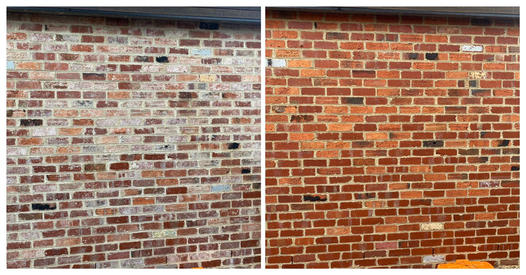
Our High-Quality Brick Wash Acid Pressure Cleaning in Melbourne Involves
- Furthermore, our cleaning experts understand whether you employ a high/low-pressure setting to douse your bricked surface. They decide this during their pre-cleaning inspection by examining the amount of dust/grime/acid burns, existing fissures, and the level of cleaning required.
- To soften the mortar enough, an acid wash combination is used throughout the operation. After that, the damaged area is agitated with a scouring brush and washed thoroughly with high-pressure clean water.
- Our skilled acid wash bricks cleaning is the most cost-effective solution to keep your property’s bricks looking good. Quality, safety, dependability, and complete client satisfaction are our top priorities.
- We employ high-quality Hydrochloric acid and high-pressure cleaning to provide the greatest results for your brickwork surface, which includes breaking down the most tenacious acid burns, stains, and dangerous components.
- Our high-pressure brick experts always use the proper equipment and instruments to remove not acid but also dirt, filth, oil, and any existing mould from the existing brick surface.
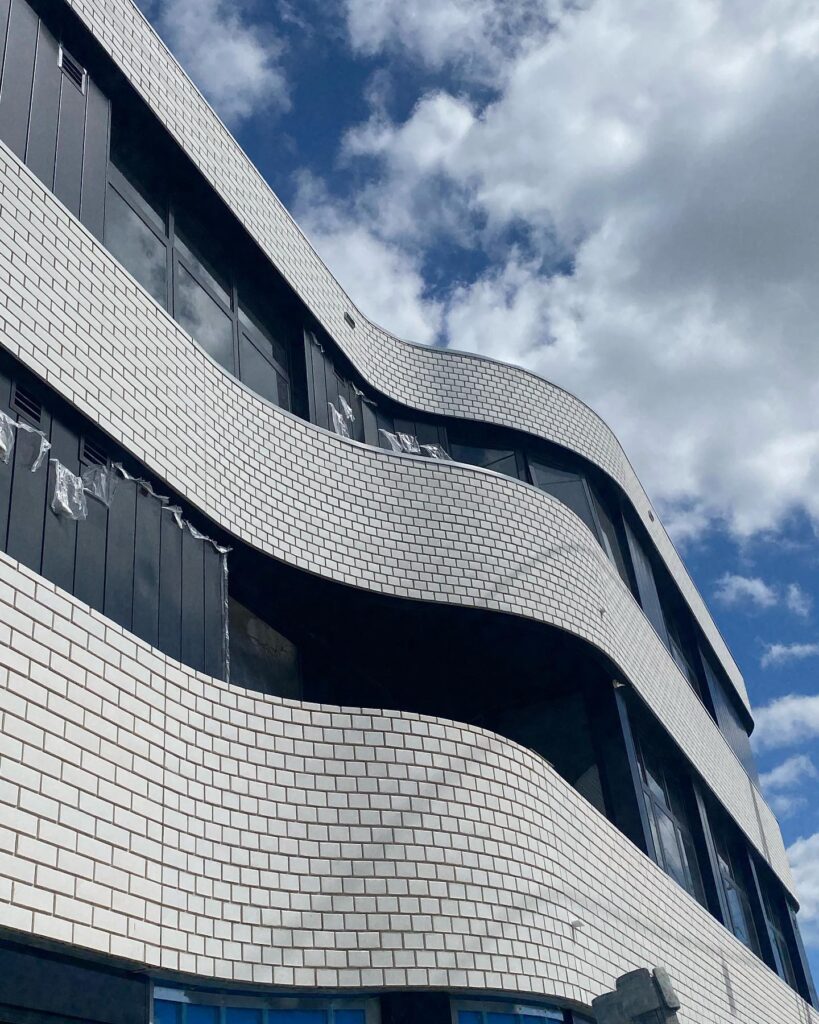
FAQ
When Should Bricks Be Acid Cleaned?
Except for Glazed bricks, which should be cleaned as they are installed, bricks should be cleaned between 7 to 14 days of being laid.
Bricks should be cleaned with a soft broom at the end of the day for the Aspire and our slurried ranges, followed by scrubbing off any mortar the next day with a hand brush and plenty of water.
Preparation For Acid Pressure Brick Cleaning
Preparing for acid brick cleaning is essential to ensure the process goes smoothly and effectively. Begin by thoroughly inspecting the brick surfaces to be cleaned, noting any areas of heavy grime buildup, stains, or damage. Next, protect surrounding areas with drop cloths or plastic sheeting to prevent accidental exposure to the acid solution. Wear appropriate personal protective equipment, including gloves, goggles, and a respirator, to safeguard against potential hazards. Dilute the acid solution according to manufacturer instructions, ensuring it is well-mixed and ready for application. Lastly, test a small inconspicuous area first to assess the reaction before proceeding with the full cleaning process. With careful preparation, acid brick cleaning can be carried out safely and successfully, restoring the beauty of your brick surfaces.
What is the recommended procedure when using brick acid cleaner?
- A metal or wooden scraper should be used to remove any mortar dags. Protect any locations that may come into touch with the cleaning agent, as directed by the specific cleaner’s maker. Window frames, aluminum damp courses, and gutters require special attention.
- Soak the section of brickwork to be cleaned, as well as the neighboring surfaces underneath, with water.
- Use the proper proportion of hydrochloric acid to water. One (1) part hydrochloric acid to 20 parts water for light-colored bricks and one (1) part hydrochloric acid to 10 parts water for dark-colored bricks.
- When cleaning, avoid working in direct sunlight. Always start from the top and work your way down the wall. Only clean small portions at a time such as one square metre to enable appropriate time to wash off the cleaning solution and avoid stains. Allow 3-6 minutes for the solutions to sit on the wall before cleaning. Avoid scrubbing the joints.
- Rinse vigorously to ensure that all acid brick cleaning solutions have been gone.
What is Our Brick Acid Cleaning Process?
- Throughout the process, a hydrochloric acid solution is utilized to suitably soften the mortar.
- The injured area is next scraped with a scrub brush and thoroughly cleansed with clean water (at high pressure).
- To achieve the best results for your brickwork surface, we use top-grade Hydrochloric acid. Its primary role is to dissolve the cement in the mortar mix that has been left on the brickwork to enable proper cleaning. The brick cleaning acid and high-pressure washing entail breaking down the most resistant of acid burns, stains, and dangerous components.
- Our high-pressure brick professionals always utilize the appropriate tools and equipment to remove not just acid, but also dirt, filth, oil, and mold from the existing brick surface.
How much does it cost to do the acid brick wash?
Acid brick cleaning services range from $450 to $5000, although your service may cost more or less. We will provide an estimate based on the complexity of the task and the amount of time required to clean your bricks.
What are the types of brick stains that we remove?
Efflorescence is a crystalline deposit of salts that can form when water is present in or on brick. Water, rain, and snow are the principal moisture sources that can affect the degree of efflorescence.
- White Scum (Silicate Deposits)
Lime Run brickwork may have discoloration over the face or on smaller, irregularly shaped patches. It is usually associated with cleaning brickwork with unbuffered hydrochloric (muriatic) acid solutions or with insufficient dampening or rinsing of the brickwork during cleaning.
- Vanadium (Green or Yellow Stain)
It can be found on red, buff, or white brick, although it is more noticeable on lighter-colored brick. The vanadium salts cause these stains to originate in the raw materials used to make the brick. Acid washing before addressing vanadium stains might make the stain more unattractive and harder to remove. Acid burn is produced by the inappropriate use of an acid cleaning process. The stains are caused by the acid reacting with iron oxides found naturally in bricks or mortar.
- Manganese (Brown Stain)
This stain is caused by the use of manganese oxide as a coloring additive in tan, brown, black, or gray brick and its reaction to acid.
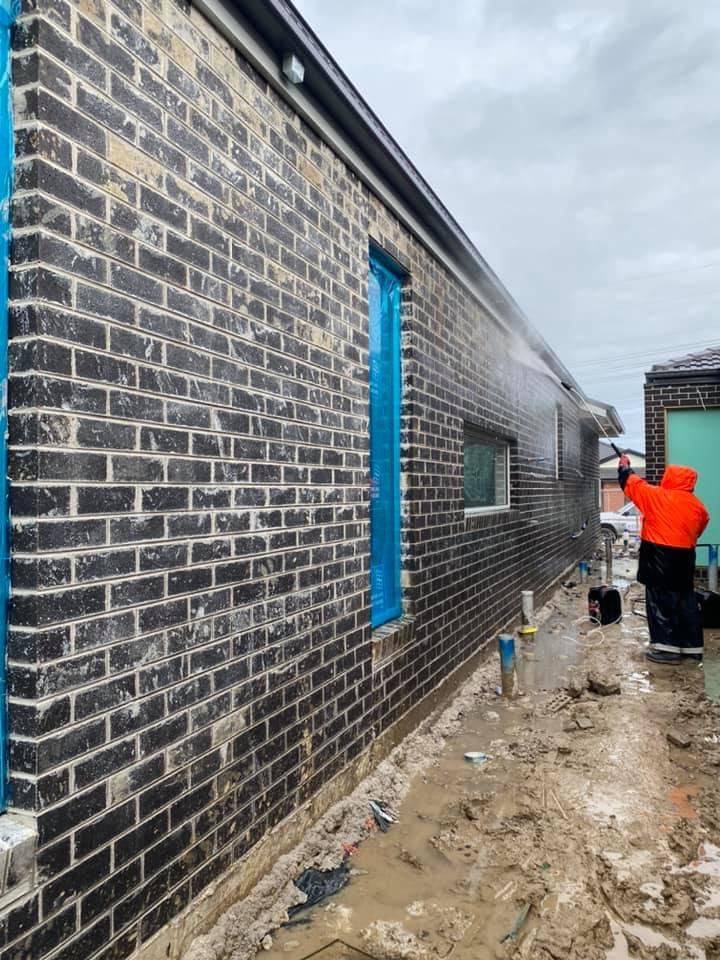
What is Acid Burn?
Acid Burn, known as Iron oxide stain is a production of yellow, orange, or brown rust-like on the face of the brick. It may also leach into the mortar joints as a result of the interaction between the iron oxides in the brick and or mortar sand and the application of hydrochloric acid. Acid burns, commonly referred to as iron oxide stains, manifest as yellow, orange, or brown rust-like discoloration on the surface of bricks. These stains can also seep into mortar joints due to the interaction between iron oxides present in the brick and/or mortar sand and the use of hydrochloric acid.
Acid Burn can occur as a result of a variety of reasons, the most prevalent of which are.
-The failure to adequately moisten the bricks before applying the acid.
-The failure to rinse the acid after the treatment.
-The failure to complete the neutralizing procedure with high iron content bricks when necessary.
– Working in bright sunshine.
Comprehensive Guide to Brick Cleaning and Maintenance in Melbourne
Maintaining the aesthetic and structural integrity of brickwork is essential for property owners in Melbourne. This detailed guide provides insights into various brick cleaning methods, including brick washing, acid washing, and pressure cleaning, ensuring your brickwork remains in pristine condition.
Preparing for Brick Cleaning
Before commencing any brick cleaning process, it’s important to prepare the brickwork to ensure the cleaning agents and techniques used do not damage the bricks or mortar. Start by thoroughly hosing down the wall to saturate the brickwork, which helps in loosening mortar dags and surface dirt.
Pressure Cleaning for Brickwork
Pressure cleaning is an effective method for brick washing, particularly for large areas. However, it must be done carefully to avoid damaging the bricks or mortar joints. Here are some tips for safe pressure cleaning:
– Use a low-pressure setting to prevent eroding the mortar.
– Keep the nozzle at least 12 inches away from the brick surface.
– Use hot water for better results, as it helps in breaking down dirt and grime more effectively.
Introduction to Brick Cleaning
Brick cleaning is a crucial maintenance task that helps preserve the appearance and longevity of brick structures. Whether it’s a historical building or a modern residence, effective brick cleaning can prevent decay and enhance visual appeal. In Melbourne, professional brick cleaners offer specialized services to tackle different types of stains and dirt accumulation on bricks.
Acid Washing Technique
Acid washing is a popular method used by many brick cleaners Melbourne due to its effectiveness in removing stubborn stains. Here’s how you can perform acid washing safely:
Safety First: Always wear protective gear, including gloves, goggles, and protective clothing. Hydrochloric acid, commonly used in brick cleaning, is highly corrosive.
Dilution: Mix 1 part hydrochloric acid with 10-15 parts water. This ratio is crucial as using too much acid can damage the brickwork.
Application: Apply the diluted acid solution starting from the top of the wall and work your way down in small sections, using a stiff-bristled brush for scrubbing.
Rinsing: Continuously hose off the acid and sludge as you clean to prevent the acid solution from drying on the bricks.
After acid washing, apply a neutralizing solution such as “NEUTRA” to balance any residual acid on the brickwork, especially important for indoor cleaning projects.
Special Considerations for Brick Cleaners Melbourne
When hiring brick cleaners Melbourne, ensure they are experienced and have a good understanding of the different types of bricks and the appropriate cleaning methods. Whether it’s hand acid washing or pressure cleaning, professional brick cleaners can provide tailored solutions based on the condition and type of your brickwork.
Regular maintenance and cleaning of brickwork not only enhance the curb appeal of your property but also extend the life of the material. Whether you opt for DIY methods like acid washing or professional brick cleaning services in Melbourne, it’s important to use the right techniques and safety measures. For best results, consult with professional brick cleaners who can assess and recommend the most effective cleaning method for your brickwork.
By following this guide, property owners in Melbourne can ensure their brick structures remain clean, intact, and beautiful for years to come.
